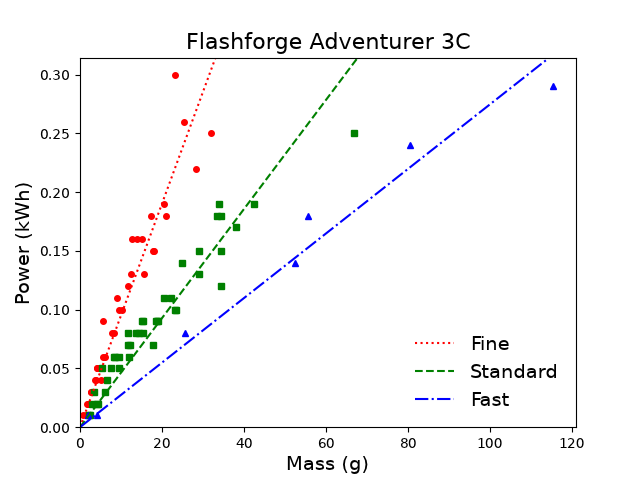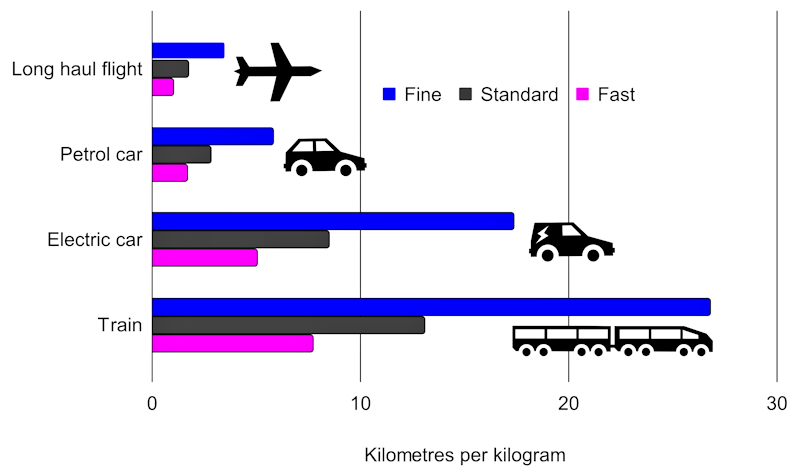We live in a time where everything we do needs to be judged in terms of the impact it has on Planet Earth. And that judgement can often be quite tricky if we want to work out the equivalent carbon dioxide (eCO2) emissions. For example, when looking at FDM 3D printing there are many aspects of the emissions to consider, such as the machine manufacture, machine use, filament manufacture, and even things as basic as having equipment and supplies delivered. But that’s obviously no excuse for not trying, so I thought I’d see if I could work out what the eCO2 impact might be of the electricity my Flashforge Adventurer 3C 3D printer uses, as a rough starting point for more environmentally sensitive 3D printing decisions.
To start with I kept a spreadsheet of things I 3D printed over the course of around one year. It included the details of the printer settings, such as temperature (200 to 210C with bed at 50C), filament (all PLA) and quality: i.e. fast, standard or fine. I also weighed each print and measured the electricity use in kilowatt hours (kWh) using a monitor that went between the power plug and socket. I collected those data for 87 prints in total (I did more, I just didn’t always remember to record them). As I generally only 3D print small(ish) models, those prints came to a total mass of 1495 grams. And they used a total of 8.65 kWh of electricity which in monetary terms is in the order of two UK pounds, US dollars or European Euros.
Then I wrote a Python script to load the spreadsheet and do some calculations. It also drew me a nice graph of the results, which you can see below. It shows the trends for the three quality options in the Flashforge slicer (fine, standard or fast), all of which seem to be a linear(ish) relationship between mass and electrical power consumption. Larger prints strayed further from the trend lines than smaller ones though, and most likely I think that’s largely due to things like variations in travel distance between extrusions. And for comparison, please note that I used the stock 0.4mm Flashforge Adventurer 3C nozzle and the Flashprint 5 slicer.

But, of course, we all want to know what the eCO2 impacts are of our 3D printing electricity consumption. So I looked for some data on emissions per kilowatt hour. It varies a lot between countries, and even based on what time of day we print, but I decided on a current value of 100g per kWh. I say currently as the emissions impacts of electricity are expected to fall a lot over coming years, due to things like increased use of renewable energy and improved efficiency of distribution (currently around 35%). So based on that, and the trendlines in the above graph, I was able to estimate the emissions per kilogram (kg) of 3D printing filament, for the three printing qualities, as in the table below.
| kWh per kg | kg eCO2 per kg | |
| Fine | 9.504 | 0.950 |
| Standard | 4.637 | 0.464 |
| Fast | 2.745 | 0.274 |
And based on the same information I was able to calculate that the electricity I used for the 87 prints caused total eCO2 emissions in the order of 0.86 kg. While that’s obviously very interesting it doesn’t really tell us how important it is in terms of our personal sustainability actions. So to help that I looked for data on the emissions caused by our travel choices, as a comparison. Below is a chart based on that, showing how many kilometres (sorry non-metric readers) I could travel, using a few modes of transport, for the same emissions I create per kilogram 3D printed: that is, for many of use, per filament reel.

Of course, the chart is just an aid to thinking about how we can offset the emissions due to 3D printing. So for my data I could claim to completely offset my 87 prints’ electricity eCO2 by avoiding one return train trip to somewhere around 14 miles away. And if you like long-haul holiday flights, one vacation moved somewhere closer might even obliterate your 3D printing electricity use for years to come. While that is just for the printers’ electricity use, I think it does also show that 3D printing is quite environmentally friendly a hobby compared to activities that involve plenty of travel.
You may also be interested to know that, according to the National Trust, one tree can, over its lifetime, remove a whole metric tonne of carbon dioxide from the atmosphere. So if you’re feeling guilty about your 3D printing emissions you could have a tree planted somewhere you know it’ll survive to old age. That way you could argue that you’re covered for local electricity use for a whole 1000kg of 3D printing fun. For me I think that’s more than a lifetime of 3D printing!
And finally, so you can make the most of the information I’ve provided on my 3D printer, I thought I should leave you with some information on the three quality settings I used in the above musings. So, the table below includes some of the main settings together with an estimate of print time for a 100mm cube: it’s the slicers’ estimated time which I normally find quite realistic. And you may like to know that the fast settings use quite a lot less filament than the others: compared to fast standard uses, for the 100mm cube, around 28% more, and fine around 36% more, both largely due to the fill densities. Hopefully you can use this information to adjust my figures to be more relevant to your machine.
| Fine | Standard | Fast | |
| Fill density | 15% | 15% | 10% |
| Print speed | 40 mm/sec | 60 mm/sec | 80 mm/sec |
| Travel speed | 70 mm/sec | 80 mm/sec | 100 mm/sec |
| Hours per kg | 104 | 61 | 52 |
Of course, there’s much more to 3D printing environmental issues than just the emissions due to electricity use, and I’ve only started looking at how to estimate it. But, it is an important part of it, and one we have more control over, so I hope you found my brainstorming thoughts interesting and maybe even useful 🙂



